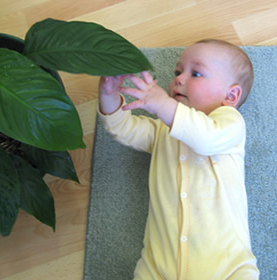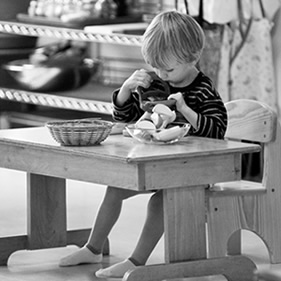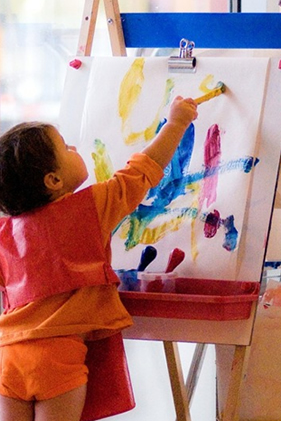Your child is a billionaire. Yes! Children are born with 100 billion neurons, just waiting…waiting for stimulation, waiting for experiences, and waiting to connect. The Young Children’s Community, for children from the ages of 0-3 years, provides these formative experiences for your child during this important stage of his life.

THE ENVIRONMENT
There are 2 components to the 0 to 3-year-old age group: a cozy home-like environment for the non-walking children, and a comfortably created place for the walking child to discover his world by working in it.
Understanding and following the needs of the child, and not necessarily those of the adult, the space is created with his success in mind. The furniture is small, very small, to fit the proportions of her body. All of the materials and equipment are life-like, assimilating real objects, but once again, small; designed for use by her tiny hands.
• The Non-Walking Room (typically 2 – 14 months of age)
Everyone wants the best for their babies. If it is not home, we try to make it mimic home the best we can. In the environment for the infants and the non-walking children, we create 4 areas that are found in homes: sleeping, personal care, eating, and living/playing.
There is an area just for sleeping; a cozy, quiet area, with beds on the floor available to the children whenever they need to rest. Personal care and hygiene also have their own space. Bathing, changing, dressing, and everything that belongs to developing the awareness and necessity for caring for our own bodies is contained in one area.
The eating, or food area, has everything from a comfortable chair for the adult to feed a baby, to a small sturdy table and chair presenting the child with a different way to eat. Plates, utensils, and even drinking cups are all part of the eating area.
Every home has one area where the family gathers. Our space too provides the child with opportunities to play (and work) at developing the skills, both fine and gross motor, he will need to move on to higher learning.
• The Walking Community (typically 14 – 36 months of age)

This is a community within itself. Here too, we divide the room into areas, to help focus the child’s attention and interests. There is still a place to rest; quietly and peacefully.
The personal care space continues to focus on personal hygiene. We work on independent dressing and undressing skills and may introduce toileting.
The eating area expands, and now includes a place for the children to help with the preparation of the food they will eat. This area is rich in language, sensory input (ah, the smell of ripe strawberries, waiting to be cut!), and real experiences, with real tools, for a real purpose.
Our “living room” now holds shelves with carefully chosen activities that will match the developmental stages of the child. Shelves are rich with materials to encourage language development, art, music, and manipulative play. Everything is designed to help the child refine skills that are based on real-life activities.
PARENT COLLABORATION
Particularly with this age group, working with the parents is of utmost importance. Whether our teachers are involved in giving prenatal information or helping parents to create a beautiful environment for their child at home, we provide support to make the infant and toddler years productive and happy for the whole family.

OUR GOAL
When all of this falls into place, we can:
- provide experiences that stimulate the senses
- enrich the child’s vocabulary and understanding of language
- provide time for the child to repeat and master activities as long as it is productive
- teach our children how to use tools in their environment such as eating utensils, brooms, sponges, etc.
- give children the opportunity to learn, through experiences, a sense of self-esteem, self-worth, and self-confidence.
Montessori used the phrase, “Help me to do it by myself”. Very young children working toward independence in eating, dressing, and toileting, are really working toward what they want to do. We take each child as an individual, allowing them to go at his or her own pace, to achieve independence.
Sometime between the ages of 2.5 to 3 years of age, your child will start to give us signs that he is ready to move up. His language skills will start to develop rapidly; he will express a growing independence in self-care and other work; he will want to know what is outside of the Young Children’s Community!
He is now ready to transition to the Primary classroom, for children from the ages of 3 to 6 years.